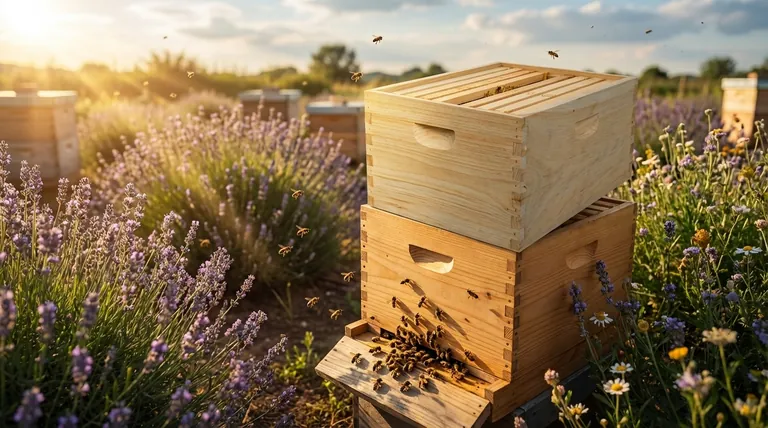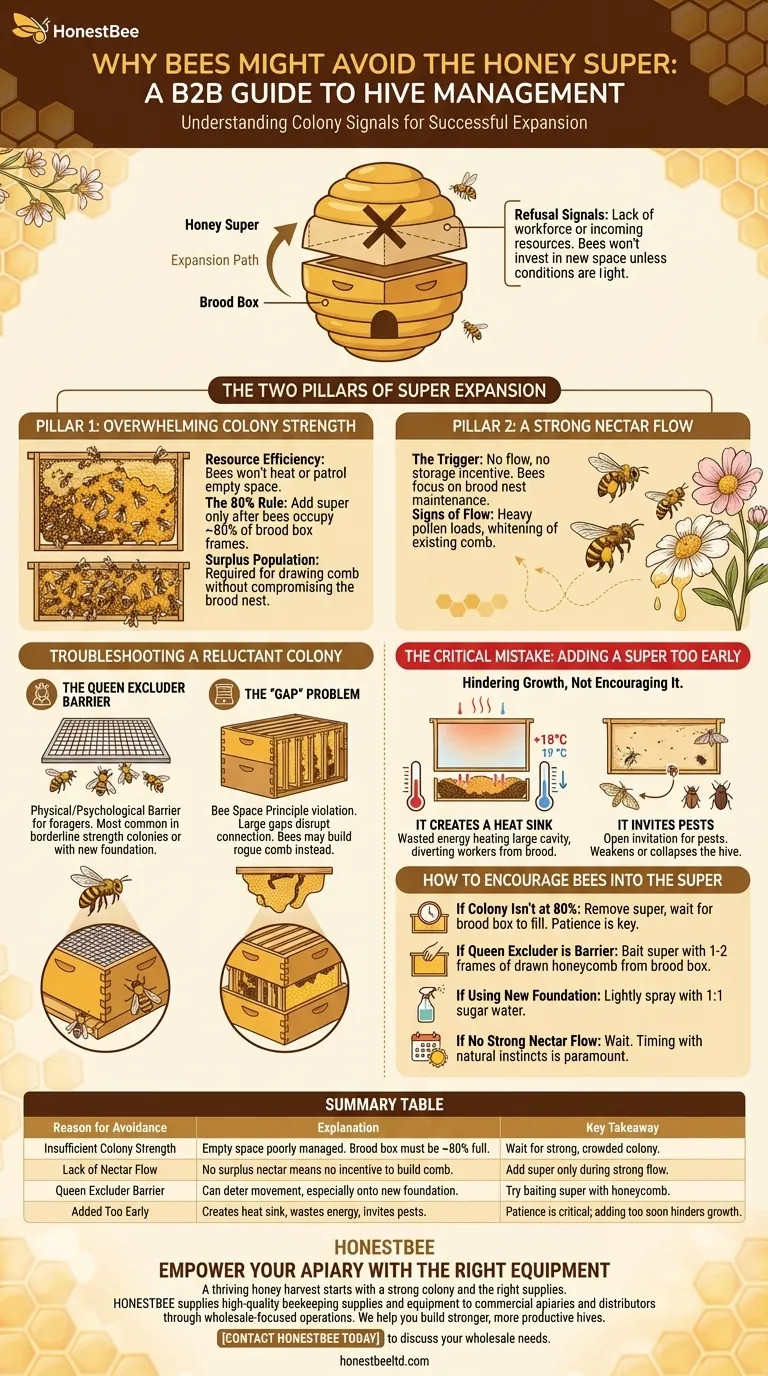At its core, a colony's refusal to use a honey super is a clear signal that they lack either the necessary workforce or the incoming resources to justify expanding their home. Bees will not invest energy into a new space unless the conditions are right, primarily meaning the hive is already crowded and a strong nectar flow is underway.
The honey super represents a surplus storage area. Bees will only move into and utilize this space when their primary living and brood-rearing quarters are nearing capacity and they have an abundance of incoming nectar to store.
The Two Pillars of Super Expansion
For bees to "move upstairs" into a honey super, two non-negotiable conditions must be met. These are the fundamental drivers of hive growth and honey production.
Pillar 1: Overwhelming Colony Strength
Bees operate on a principle of resource efficiency. They will not attempt to heat, patrol, and manage a large, empty space until their existing area is full.
A common beekeeping guideline is the 80% rule. You should not add a super until the bees have drawn out comb and are actively using at least 80% of the frames in the top brood box.
A strong colony has the surplus population of worker bees needed to venture into the super, draw out new comb, and begin processing and storing nectar without compromising the health of the brood nest below.
Pillar 2: A Strong Nectar Flow
Even a powerful colony will ignore a new super if there is no food to store in it. A nectar flow—the period when major floral sources are producing abundant nectar—is the trigger for honey production.
Without this external signal, the bees have no incentive to build out wax for surplus storage. They remain focused on maintaining the brood nest and managing their existing stores.
Signs of a nectar flow include seeing heavy pollen loads on returning foragers and observing "whitening," where bees add fresh, white wax to the tops of existing comb to extend the cells for capping.
Troubleshooting a Reluctant Colony
If your colony is strong and you believe a nectar flow is on, other factors can create hesitation.
The Queen Excluder Barrier
A queen excluder is a useful tool but can act as a physical and psychological barrier. Forager bees, accustomed to unimpeded movement, may be reluctant to squeeze through the grid.
This hesitation is most common in colonies that are borderline in strength or when bees are being asked to work on new, undrawn foundation. The excluder adds an extra layer of difficulty that can delay their upward movement.
The "Gap" Problem
Bees are meticulous architects and adhere to a principle known as "bee space." If the gap between the top bars of the brood box frames and the bottom bars of the super frames is too large, they may not see the super as a connected part of the hive.
This can happen with ill-fitting equipment. The bees may simply choose to build rogue comb in the gap rather than move up into the frames as intended.
The Critical Mistake: Adding a Super Too Early
Adding a honey super before the colony is ready is one of the most common errors in beekeeping. It does not encourage growth; it actively hinders it.
It Creates a Heat Sink
The brood nest must be kept at a consistent temperature (around 95°F or 35°C). Adding a large, empty box on top forces the bees to expend enormous energy trying to heat a much larger cavity.
This wasted energy diverts workers from raising brood and foraging, ultimately slowing the colony's development.
It Invites Pests
An empty, unpatrolled super is an open invitation for pests like wax moths and small hive beetles. A strong, compact colony can easily defend its space. A colony stretched thin trying to manage too much empty volume cannot.
This creates a high-risk environment that can weaken or even lead to the collapse of the hive.
How to Encourage Bees into the Super
If you've assessed the situation and believe the conditions are right, you can use a few techniques to entice the bees upward.
- If your colony isn't at 80% capacity: Remove the super and allow the bees to continue building out the brood box. Patience is your most effective tool.
- If the queen excluder seems to be the barrier: Try "baiting" the super by moving one or two frames of drawn, open honeycomb from the brood box up into the center of the super. Ensure the queen is not on these frames.
- If you are using brand-new foundation: Lightly spraying the new frames with a 1:1 sugar water solution can encourage the bees to move up and begin working the wax.
- If a strong nectar flow has not started: Wait. The bees know when the resources are available, and forcing them before the time is right is counterproductive.
By aligning your timing with the colony's natural instincts for strength and resource availability, you empower them to do what they do best.

Summary Table:
| Reason for Avoidance | Explanation | Key Takeaway |
|---|---|---|
| Insufficient Colony Strength | Bees won't manage empty space until the brood box is ~80% full. | Wait for a strong, crowded colony before adding a super. |
| Lack of Nectar Flow | No surplus nectar means no incentive to build comb for storage. | Add a super only during a strong nectar flow. |
| Queen Excluder Barrier | Can deter bees from moving up, especially onto new foundation. | Try baiting the super with a frame of honeycomb. |
| Added Too Early | Creates a heat sink, wastes energy, and invites pests. | Patience is critical; adding a super too soon hinders growth. |
Empower Your Apiary with the Right Equipment
A thriving honey harvest starts with a strong colony and the right supplies. If you're managing commercial hives or distributing beekeeping equipment, partnering with a reliable wholesale supplier is key to your success.
HONESTBEE supplies high-quality beekeeping supplies and equipment to commercial apiaries and distributors through wholesale-focused operations. We help you build stronger, more productive hives.
Contact HONESTBEE today to discuss your wholesale needs and ensure your operation has the tools for success.
Visual Guide

Related Products
- Langstroth Honey Bee Box Hive Boxes for Different Depths
- Professional 500g Sectional Comb Honey Frame System for Beekeeping
- Australian Langstroth Beehive Boxes for Beekeeping Wholesales
- Portable Bee Mating Hive Boxes Mini Mating Nucs 8 Frames for Queen Rearing
- Professional Insulated Plastic Bee Hives
People Also Ask
- Why do you need two bee hives? Boost Your Apiary's Success with Smart Risk Management
- How should hive boxes be aligned after reassembly? Ensure a Perfect Seal for Hive Health
- What is the best time to inspect a hive? Optimize for Bee and Beekeeper Safety
- How is checking honey supers in a Langstroth hive different from inspecting Honey Flow supers? A Guide to Disruptive vs. Non-Invasive Methods
- What is the purpose of the boxes in a Langstroth hive? A Guide to Modular Beekeeping Success



















